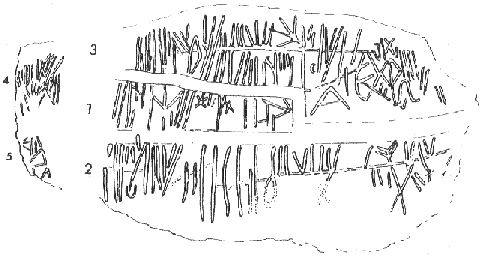By Roger B. Wise
Comment on Fell (1983) and Nyland (1996)
© 2003 Roger B. Wise, used with permission
<< Science Works | Another Translation | Ogam Contents >>

© 1983 WV Division of Natural Resources, used with permission
Edo Nyland (1996) agrees with Fell's transliteration of the petroglyph to ogham characters and the Latin alphabet. He disagrees with the translation, however. Nyland says it was not done in Old Irish and Berber, but in Basque. Armed with Fell's letter conversions and copying Fell's methods, he used a Basque dictionary to translate the petroglyph somewhat differently (the detailed work is on his web page, linked below). Nyland and Fell also place the five sections of the petroglyph in different sequences.
|
Translation of Edo Nyland from Basque |
Translation of Barry Fell |
|---|---|
|
Nyland's first line is labeled Section 3 in the illustration: |
Fell placed this line last in his sequence: |
|
Section 1 -- Nyland's second line: |
Fell placed this line first: |
|
Section 2 -- Nyland's third line: |
Fell placed this in the middle: |
|
Sections 4 and 5 come last: |
Fell's section 4 is an unrelated text: Fell's section 5 is an unrelated text: |
Nyland adds: "The symbol which Dr. Fell interprets as the Greek letter 'omega' is probably a sketch of the ground plan of the wooden fence, while his 'alpha' character may illustrate the A-frame type of construction used to build the bison fence."
References Cited
Fell, Barry
- 1983 "Christian Messages in Old Irish Script Deciphered from Rock Carvings in W. Va." Wonderful West Virginia Volume 47, No. 1, pp. 12-19
Nyland, Edo
- 1996 The Horse Creek Petroglyph of West Virginia Accessed January 14, 2003.PDF
Additional Reading
Wise, Roger B.
- 2019 "Solstice Observations at the Luther Elkins Petroglyph (46WM3)." West Virginia Archaeologist Volume 59, No. 1, pp. 15-20.
<< Science Works | Another Translation | Ogam Contents >>
